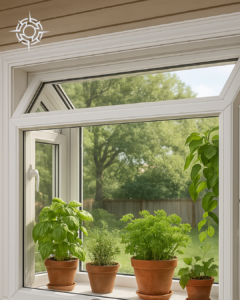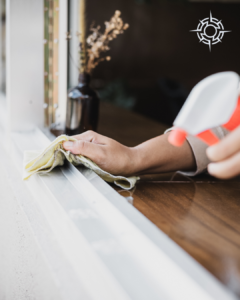“Crash!!”
You turn and see something out of “The Sandlot“: a ragtag group has hit a stray baseball through your window. What to do?
Whether it’s a misplaced throw or moving a bulky piece of furniture, windows bear the brunt of many home accidents. Surprisingly, the average lifespan of modern residential windows spans around 30 years, but sometimes, unexpected events can cut this lifespan short. Recognizing the potential for such accidents is the first step in managing them effectively. This guide will walk you through how to assess the damage and decide whether a quick fix will suffice or if a full replacement is needed, ensuring your home remains comfortable and secure despite life’s little surprises.
Assessing Window Damage
When faced with a broken window, the first step is to assess the extent of the damage carefully. This will determine whether a repair is feasible or if a full replacement is required. Start by examining the window pane for any cracks, chips, or punctures. Small, isolated cracks or chips often can be repaired, especially if they are not near the edges of the glass where they are more likely to spread. A high-quality epoxy or resin can seal these defects and restore the integrity of the pane.
However, if the damage includes multiple cracks, especially those that create a spider web pattern, or if the pane has shattered completely, replacement is the safest option. These types of damage compromise the structural integrity and insulation properties of the window, making repairs impractical and unsafe.
Similarly, inspect the window sill and frame for signs of damage. Wood frames can suffer from rot or warping, which may necessitate repairs to the frame itself or potentially its replacement if stability is compromised. For metal or vinyl frames, look for bends, warps, or breaks that could impact the frame’s ability to hold the pane securely.
By methodically assessing each element of the window, you can make an informed decision on the best course of action to ensure your home’s safety and energy efficiency.
Temporary Measures for Broken Windows

If a window breaks and you can’t immediately repair or replace it, there are steps you can take to prevent further damage and maintain your home’s thermal regulation in the meantime. One of the simplest temporary solutions is to use heavy-duty plastic sheeting. Cut the plastic to size and secure it tightly over the broken window using strong tape, such as duct tape. This creates a barrier that helps keep out moisture, drafts, and pests while preventing further damage to the window sill or frame.
For more serious breaks or in cases where safety is a concern, boarding up the window may be the best option. Use plywood cut to the size of the window opening and secure it with screws or nails to ensure it stays in place. While not aesthetically pleasing, this method will protect your home from weather exposure and prevent potential injury from broken glass.
These temporary fixes can hold you over until a more permanent repair or replacement can be made, ensuring your home remains secure and energy efficient during the interim.
Repairing Minor Window Damages
For minor window damage such as small cracks, chips, or punctures, epoxy resin is an effective solution that can extend the life of the glass and restore its appearance. Here’s how to undertake this repair:
- Clean the Area: Before applying epoxy, it’s crucial to clean the damaged area thoroughly. Use a glass cleaner to remove any dust, dirt, or grease from the surface. Allow the glass to dry completely, as moisture can interfere with the adhesion of the epoxy.
- Prepare the Epoxy: Mix the epoxy resin according to the manufacturer’s instructions. Typically, this involves combining a resin and a hardener in precise ratios. Be sure to mix only as much epoxy as you need, as it begins to set after mixing.
- Apply the Epoxy: For small cracks or chips, use a toothpick or a fine-tipped applicator to gently apply the epoxy directly into the damaged area. Ensure the epoxy fills the crack or chip completely and is level with the surface of the glass.
- Cure the Epoxy: Allow the epoxy to cure as directed by the product instructions. Curing times can vary, but it’s usually recommended to let the epoxy set for at least 24 hours for optimal strength.
- Clean Up: Once the epoxy has cured, use a razor blade to carefully remove any excess epoxy from the glass surface. Be gentle to avoid scratching the glass.
- Polish the Glass: Finally, polish the repaired area with a glass cleaner to restore its clarity and shine. This step will help blend the repair into the surrounding glass, making it less noticeable.
By following these steps, you can effectively repair minor damages to your window panes. This DIY solution not only saves money but also extends the life of the window until a professional replacement can be considered.
Replacing Window Panes
If your window damage is beyond simple repairs, replacing the pane is the next step. This process involves careful handling and precise work to ensure safety and effectiveness. Here’s how to safely replace a broken window pane:
- Safety First: Before starting, wear protective gloves and safety glasses to protect against sharp glass shards. Clear the area around the window to prevent any accidents.
- Remove the Broken Glass: Carefully remove the broken glass pieces from the frame. Use a putty knife to pry out the glazing points or clips holding the glass in place. If the window is caulked, you may need to cut through the sealant with a utility knife.
- Clean the Frame: Once all the glass is removed, clean the frame thoroughly. Remove any old putty, caulk, or debris to ensure a smooth surface for the new pane.
- Measure and Cut the New Glass: Measure the opening in the frame, subtracting about 1/8 inch from each dimension to ensure a proper fit. Have a glass shop cut a new pane to these dimensions or cut it yourself if you have the proper tools.
- Install the New Glass: Place the new pane into the frame. Secure it with new glazing points or clips. Apply a layer of window putty around the edges of the pane, smoothing it with a putty knife to seal and hold the glass in place.
- Finishing Touches: Allow the putty to dry according to the manufacturer’s instructions, usually for a few days. Once dry, paint the putty to match the rest of the frame, providing additional weatherproofing and a neat finish.
- Clean Up: Dispose of the broken glass safely, and clean your work area. Finally, clean the new window pane with glass cleaner to remove fingerprints and smudges.
By following these steps, you can effectively replace a broken window pane, enhancing your home’s safety and aesthetic. Remember, if the window is large or part of a more complex installation like double-hung or casement windows, consider hiring a professional to ensure the job is done safely and correctly.
Addressing Frame and Mechanism Damages
When assessing damage to window frames and operating mechanisms, it’s crucial to understand the material and mechanism type to determine the best repair approach. Here’s how to handle common issues:
- Wooden Frames: Look for signs of rot or water damage, which typically manifest as soft spots or discoloration. To repair, remove the rotted section with a chisel, apply a wood hardener to strengthen the remaining material, and fill the void with wood filler. Sand it smooth once dry, then repaint or seal to match the existing frame.
- Metal Frames: Corrosion is the main concern with metal frames. If you find rust, sand the area down to the metal, apply a rust-inhibiting primer, and repaint the frame to prevent further decay. For severe corrosion where metal has weakened significantly, replacing the affected sections might be necessary.
- Operating Mechanisms: For windows that are tough to open or close, clean and lubricate the tracks and inspect for bent or broken parts. Replace any damaged hardware to restore proper function. In cases where the mechanism is beyond simple repairs, consult with a professional for replacement options.
By addressing these frame and mechanism issues, you can extend the life of your windows and ensure they function efficiently and securely. If the damage is extensive or if you’re unsure about the repair process, reaching out to a professional like Compass Exteriors Remodeling can provide the expertise needed to restore your windows effectively.
Choosing Replacement Windows

When it’s time to replace your windows, selecting the right type is crucial for both the functionality and aesthetic appeal of your home. Consider the following factors to make an informed decision:
- Energy Efficiency: Look for windows with good insulation properties, such as double-pane or triple-pane glass, which can help reduce your energy bills by keeping heat in during winter and out during summer. Check for the ENERGY STAR rating to ensure high energy efficiency.
- Aesthetics: Choose a style that complements the architectural design of your house. Whether you prefer the traditional charm of wood frames or the modern appeal of vinyl or aluminum, ensure the windows enhance your home’s character.
- Compatibility: Ensure the new windows fit within the existing frames if you’re not replacing them. This involves not just the size, but also the weight and operational style, which should align with the existing structure.
- Window Styles: Consider the functionality of different styles, such as casement, double-hung, or sliding windows. Each type offers different benefits for ventilation, ease of cleaning, and aesthetic preferences.
By carefully considering these aspects, you can choose windows that not only look great but also contribute to the comfort and efficiency of your home. If you need further guidance, Compass Exteriors is always ready to help with expert advice and installation services to ensure your window replacement is a success.
Conclusion
Properly assessing, repairing, and replacing windows are essential steps to maintaining your home’s safety and enhancing its energy efficiency. Whether you’re fixing a minor crack or undertaking a complete replacement, each action contributes significantly to your living environment. For those tasks that go beyond the DIY scope, Compass Exteriors Remodeling offers expert solutions. Our professionals specialize in window repair and replacement, ensuring that every project meets the highest standards of quality and durability. If you face any complex window issues, don’t hesitate to contact us at Compass Exteriors. We’re here to help you every step of the way.











